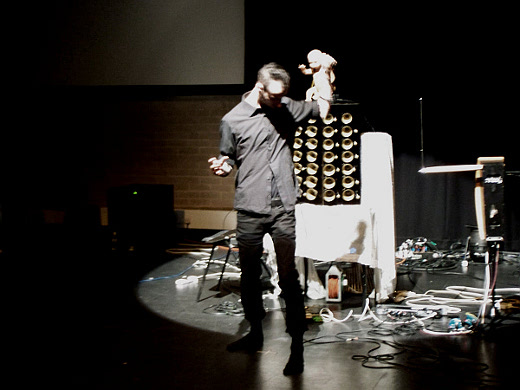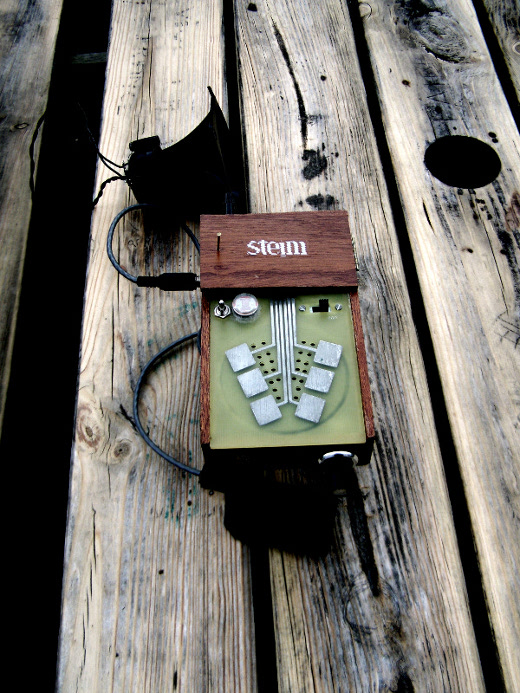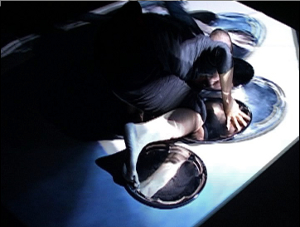Hi there!
It has been a while since my last post.
Things have been rather hectic; I’ve been caught up among travels, the Xth Sense public release (!), concerts and writing.
At the moment I’m finishing up my MScR final dissertation.
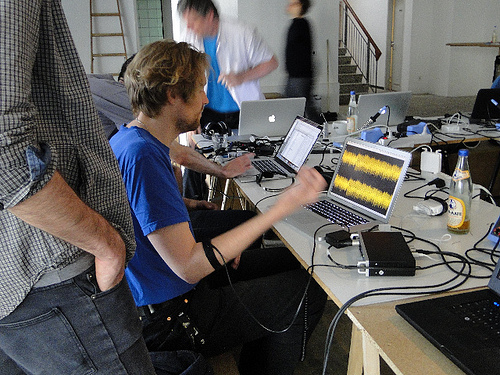
A student interfacing the Xth Sense with SuperCollider.
I’ll update the blog with some new features that have been added to the XS software, more news about the project going live, etc.
By now I thought to wet a bit your appetites with a brief audiovisual report from last amazing concert in Berlin at LEAP, Lab for Electronic Arts and Performance.
The event was organized by the LEAP staff, with guest curator Joao Pais, in collaboration with Create Digital Music and eContact! journal for electroacoustic music research (for which I curated a forthcoming issue on Biotechnological Music Performance).
I taught an XS workshop with a wonderfully enthusiastic class, and played a couple of pieces for the XS, along with Peter Kirn, using a Galvanic Skin Response (GSR) device, and Claudia Robles Angel, controlling videos and sounds with her brainwaves.
We also had the chance to attend a talk by colleague and friend Pedro Lopes. An informative and clear conversation on Human-Computer Interaction with a consistent focus on biotechnologies.
Quite an exciting week!
A set of pictures can be found on Flickr.
Below you can listen to the live recording of the three concerts.
Thanks to the lovely team at Weimar Bauhaus Universitat, we can view on-line all the talks presented at the recent Pd Convention 2011.
Below my talk “A Pd framework for the Xth Sense: enabling computers to sense human kinetic behaviour”.
Make sure to check the Convention Vimeo Channel, you will find a very good amount of inspiring material, even if you are not into Pd.
Marco Donnarumma – Xth Sense, Biophysical Music from PdCon11 on Vimeo.
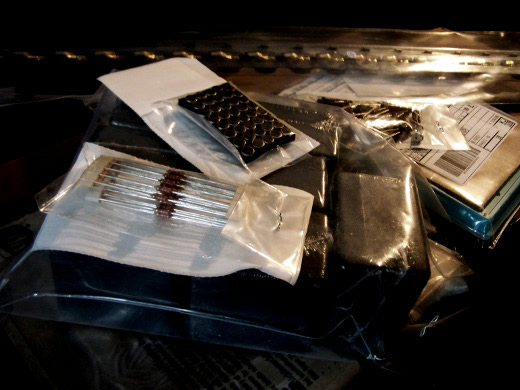
Preparing for the travel
From 20 to 24 October I visited Seoul in South Korea to present the Xth Sense and the new model of biophysical music to the Asian academic community within the frame of the SICMF/KEAMS (Seoul International Computer Music Festival and the Korean Electro-Acoustic Music Society). This engagement was endorsed by Creative Scotland, which awarded me a grant through their International Programme.
Besides, a related paper “Xth sense: a biophysical framework for the application of muscle sounds to interactive music performance” will be published in the Computer Music Journal Emile Vol. 9 soon in the upcoming month.
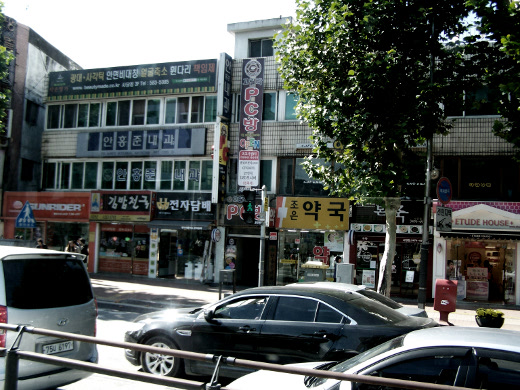
Welcome to Seoul
It was my first journey to an Asian country, although I have participated in other events in Japan, China and India via streaming interventions. Useless to say that the cultural impact was rather strong, the deep differences in society, customs and language are as fascinating as difficult to grasp.
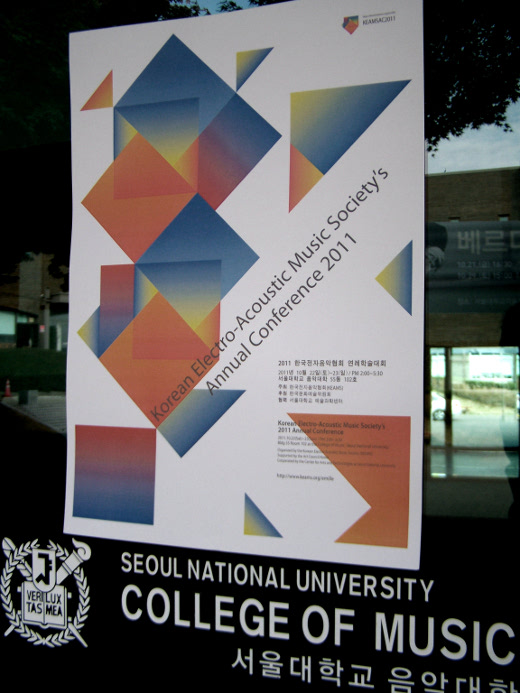
KEAMS poster at the Seoul National University
The event included night concerts hosted by the SICMF and paper presentations organized by KEAMS at the Seoul National University, College of Music. The conference was formerly introduced by Richard Dudas, an American composer which largely contributed to informing today’s computer music practice, and an exquisite person too.
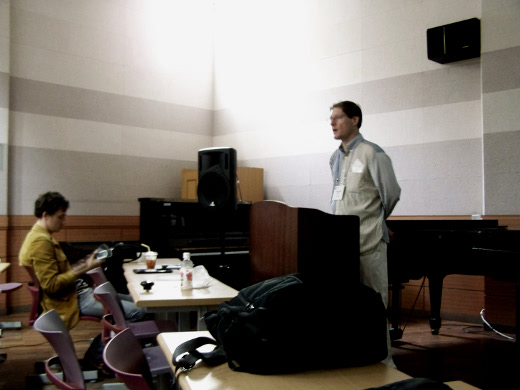
Richard Dudas opening speech
One of the first talks illustrated a site-specific installation project called Tertullia by Nicolas Varchausky. The project consisted of a multi-channel and open air system of loudspeakers located at the Mirogoj Cemetery, Zagreb, Croatia. The work approached “the space as an integrated geography, designing a path for the audience that formally resembled a radio (metaphorically transforming the space into both a receiver and a trasmitter), and creating a real time system for the sound composition.”
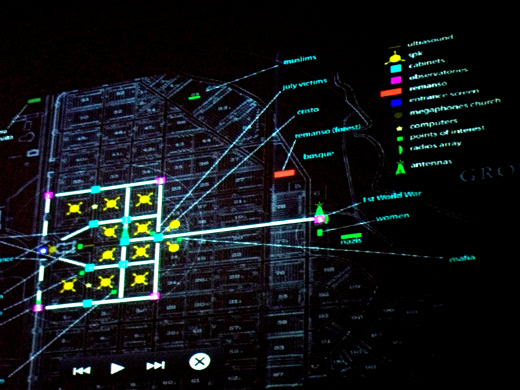
The Tertullia Project by Nicolas Varchausky et al.
The night concerts took place at the Jayu Theater, a majestic multi-purpose building provided with state-of-the-art halls and equipment. The organization was neat and succeded in making the night really enjoyable, by creating a cozy and friendly mood.
Although all pieces were executed by excellent performers, only the piece Black Crane for Geomungo positively impressed me, both sonically and structurally. Personally, I believe the other works were surely very good, but perhaps they lacked of that excellence and innovation touch that I always seek in a piece.
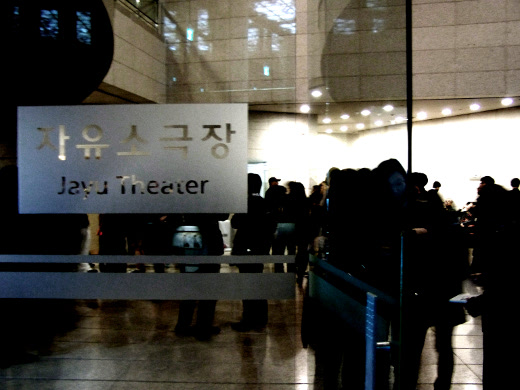
The Jayu Theater, Seoul
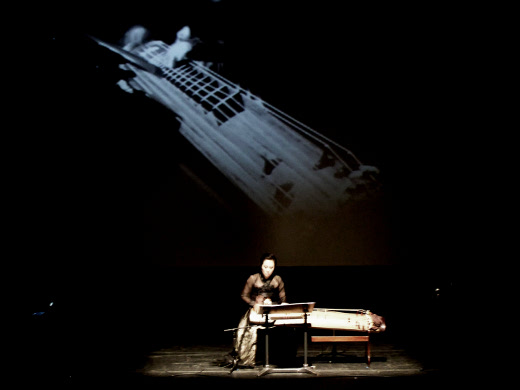
SICMF Concerts | Black Crane for Geomungo by Donoung Lee
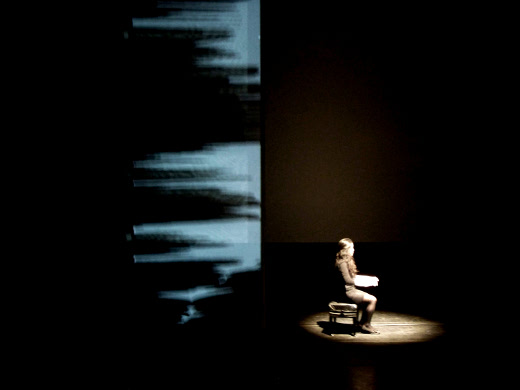
SICMF Concerts | Vpiano by Young Mee Lymn
The second day of the conference offered an exciting schedule. First off were Jieun Oh and Ge Wang from the CCRMA at Stanford University. They presented Converge, “a crowd-sourced audio-visual composition that brings together contextual autobiographical moments, captured and submitted by a group of participants, into a coherent narrative.”
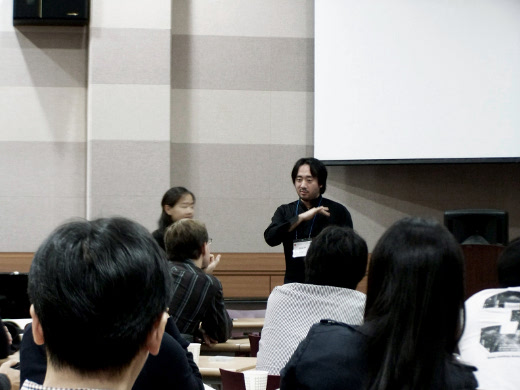
Converge by Jieun Oh and Ge Wang, CCRMA Stanford University
Next, we were delighted by a rather entertaining talk by Clarence Barlow, University of California Santa Barbara. His presentation focused on a detailed excursus through about 25 years of his personal experience with algorithmic composition… mindblowing.
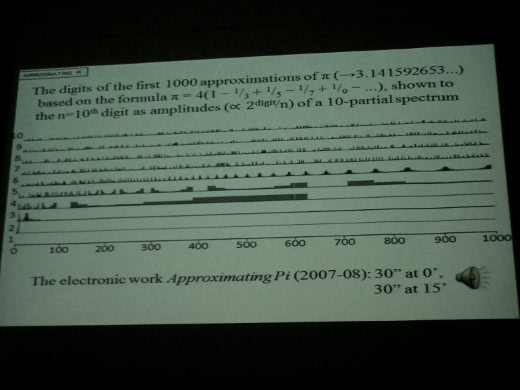
Algorithmic composition by Clarence Barlow, University of California Santa Barbara
Finally, I introduced the Xth Sense technology through an heterogeneous talk which outlined the conceptual and technical developments, along with some aesthetical considerations on the specific sonic forms that can be obtained with the XS biophysical system. I also had the time to perform a short demo.
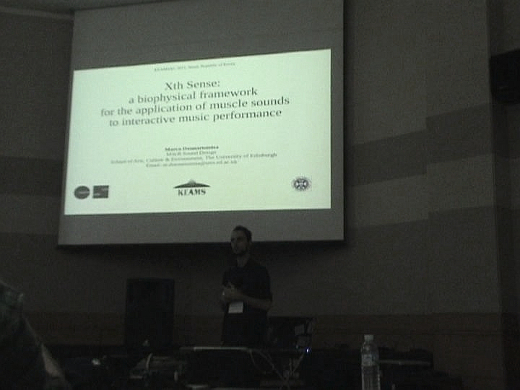
Xth Sense by Marco Donnarumma, SLE University of Edinburgh
Last but not least, Albert Chao from the University of Buffalo talked about his iMeasure custom headphones. From his website: “iM Headphones is embedded with a set of sonar sensors that take spatial readings of the physical environment and “play” particular sounds in relation to the data.”

iMeasure by Albert Chao, University of Buffalo
Unfortunately, I could stay in Seoul only few days, but the conference and the festival were well worth it. A special thanks goes to Richard Dudas and Ko Pyoung Ryang, who were capable of organizing a lovely and rich event, not to mention the amazing hospitality and the great and inspiring conversations we had. Hope to come back soon, perhaps to perform at SICMF 2012.
Here a little glimpse of Seoul (click to enlarge).
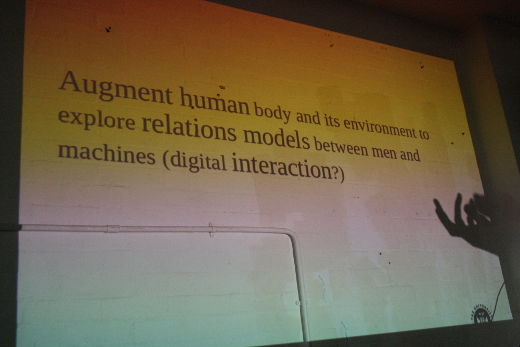
Xth Sense theoretical introduction
The third Xth Sense (XS) workshop took place at the nnnnn studios in London, shortly after the 4th Pure Data Convention.
nnnnn is the home of the relentless activities around FLOSS, sound art and obscure hacking organized by UK artist Ryan Jordan, also known for organizing the monthly and long-established Noise=Noise concerts.
When Ryan asked me to come over to make a workshop there was no doubt it would have been a fun week, it always is when I come down to London to visit friends. The course gathered a bunch of sound and media artists, alongside with few Openlab folks appearing randomly.
It all seemed quite successful, and although some participants did not have any experience at all with soldering and electronics, we moved quite rapidly through the course program.
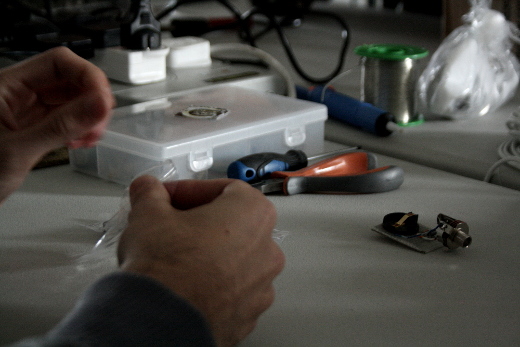
We kicked off by soldering the circuit
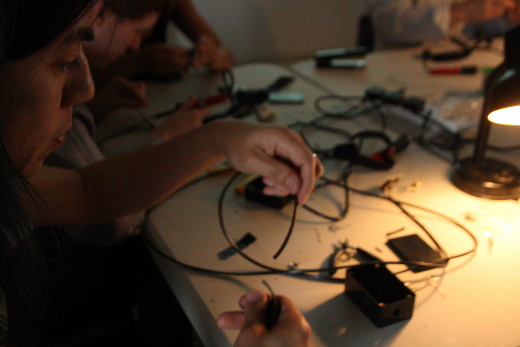
Then we refined the sensor and made it wearable
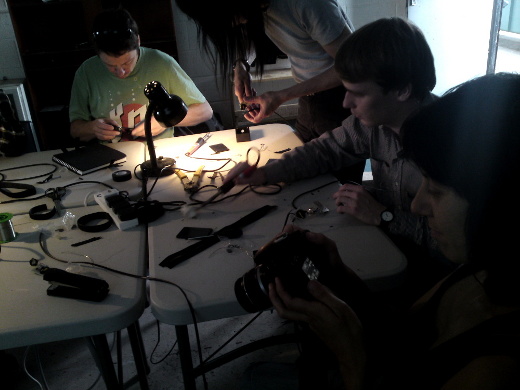
Eventually we successfully tested the biosensors
After building the XS sensors we started diving into the software framework and explored the design of sound-gestures so to become familiar with the system. It’s always pretty intuitive to get started with the XS, even though, especially for first-time users the complexity of the system may require the grasping of new concepts and techniques.
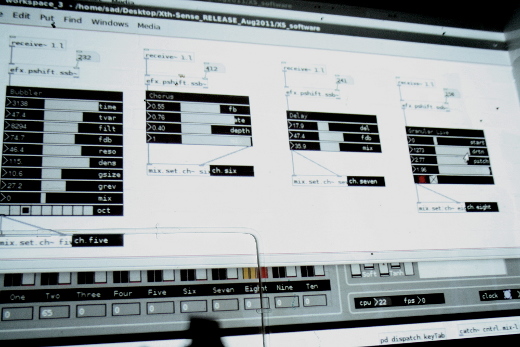
Editing a patch within the Xth Sense software
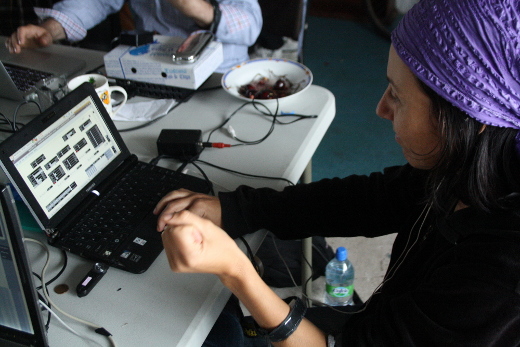
Designing the first sound-gestures
We closed the course with an open jam session during which everybody had the chance to test out the patches they created and the gestures and micro-choreography they have been working on during the week.
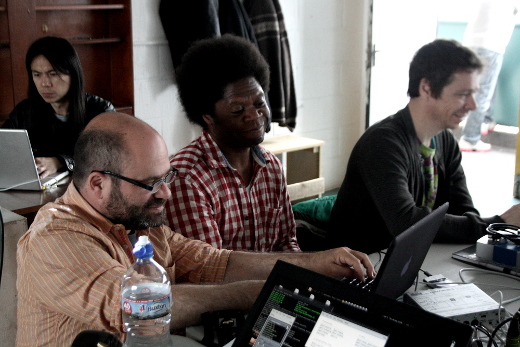
Testing the sounds definitions before the final jam session
Overall it was fun and exciting, as I also had the time and inspiration to develop the software a bit further; namely I just integrated MIDI Out support, so to send the features extracted from the biosignal to other Pd instances or external application software. I had the chance to see the students realizing with the XS some ideas that I never though to try out myself; the flexibility of the XS biophysical system seems to unveil something new every workshop I teach.
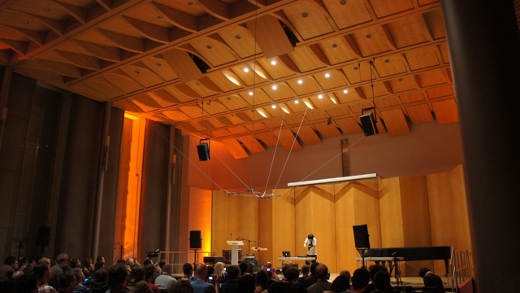
Chikashi Miyama | Black Vox
[The post has been UPDATED with a live recording of Music for Flesh II]
The Pure Data Convention is one of the best community led event I ever took part in. I’m not sure whether is the laid back attitude shared by the participants, or the excitement of showing and learning all the diverse things Pd can be used for, however the Pure Data meetings are something unique. The cloud of knowledge, techniques, good conversations and ideas that floats around the heads of the delegates is pretty special and cozy.
This year the fourth Pd Convention was organized by our friends and Pd developers Max Neupert and Bjorn Lindig, along with a team of colleagues from the Bauhaus Universitat in Weimar. I was honoured and thrilled to present the Xth Sense interactive system to the community, and eventually I had the chance to teach a workshop, give a lecture on the latest findings and perform the solo piece Music for Flesh II.
The workshop was quite fast, but we had the chance to get our hands dirty with some custom electronics and Pure Data programming for interactive, biophysical music; some pictures below.

The Xth Sense biophysical sensors
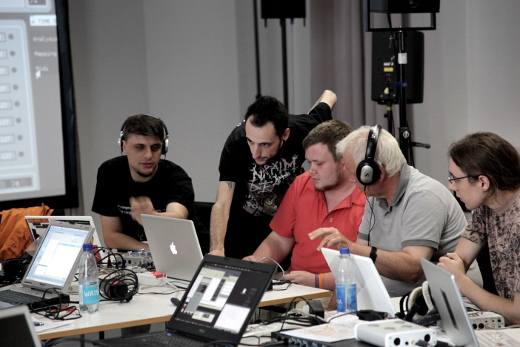
Designing sound gestures for the Xth Sense system
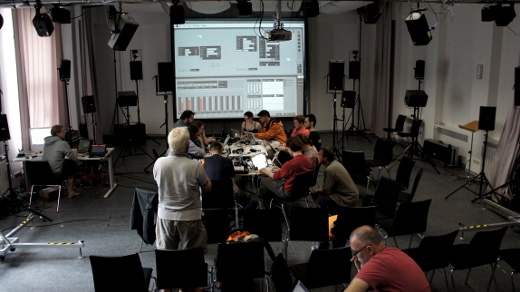
A ridiculous amount of speakers at the awesome Seam Studio.
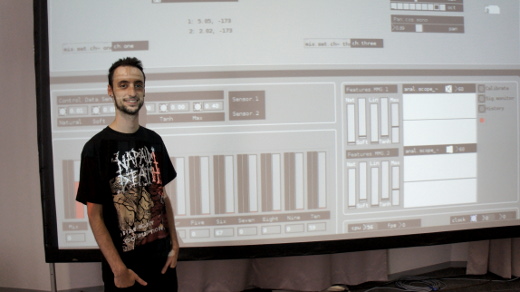
A nerd and its child.
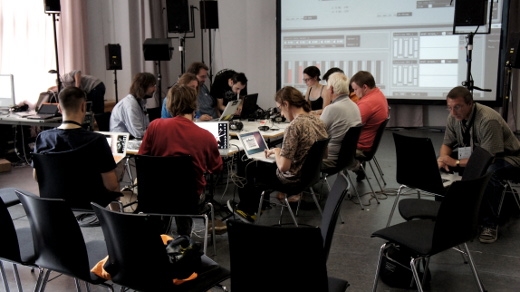
Full immersion, last hours of the course.
Personally it was a great experience as I collected some inspiring feedback and constructive critics about the whole XS project. Namely, I had wonderful conversations with friends Ricardo Palmieri and Richard Graham, that are both working on some highly recommended Pd-based projects. With Ricardo we have been considering a different standard for the production process of the XS sensors, while with Richard we discussed about the use of multiple subwoofers, the more effective impact of whole-body movements to both the sonic outcome and the audience perception, and the mediation between primal muscle sound and its computational mediation.
The latter topic is as tricky as stimulating; recently I’ve been thinking about this quite a lot, and if on one hand there is not an ultimate solution as we deal with the subjectivity of a musical aesthetic, on the other, this aspect of the research is crucial, for a deeper musical analysis could sharpen the timbrical characteristics of the XS as a musical instrument.
It is often very hard for me to be completely satisfied of a performance, but I can say the concert at the Seam Studio in Weimar was perhaps one of the best so far. Probably due to the swift anxiety of performing before the ears of my peers and colleagues, my concentration was fairly strong, and while playing I think I almost entered a trance. For the first time since March I spontaneously moved the whole body, rather than individual limbs; such a somatic behaviour triggered sound forms that I never heard before and playing the piece was far more enjoyable than usual. As simple as it gets, in contrast with single limbs contractions, whole body movements involve the excitation of a greater part of the body; thus many more oscillations are generated and the whole network of muscular tissues is excited. Sonically, this is translated in a faster dynamic and richer texture.
Here you can listen to a live recording of the piece.
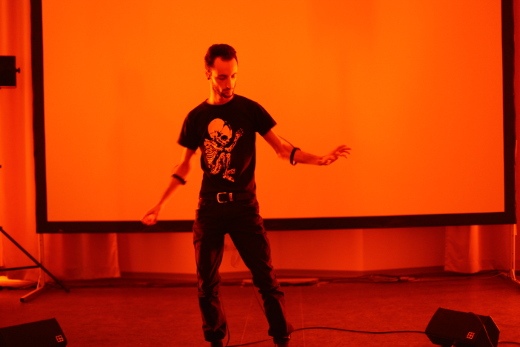
Marco Donnarumma | Music for Flesh II
The concerts program was excellent; the fourth PdCon gathered some of my favourite Pd musicians, such as Koray Tahiroğlu, Richard Graham, Chikashi Miyama (pictured at the top of the page), CHDH, Oscar Martin and Alexandre Porres. We also had an amazing exhibition, more workshops and a round table with a virtual Miller Puckette, who participated in streaming from the US. Check the program on-line to get a glimpse of the tight schedule.
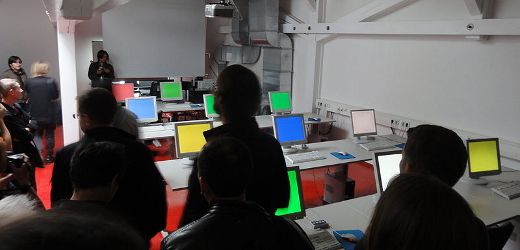
Giuliano Obici | Lanhouse Concert
Of course, I’m not forgetting about the papers; being that there were too many lectures, and the sessions were split in two rooms running at the same time I could not attend all of the presentations. However, it is hard to say which ones were the most interesting, because the diversity of the contents presented at the Convention is always so great to be almost overwhelming. If you wish to stay up to date with the latest developments of our community, you are only one click away.
A big thanks to the organization and to all the delegates that made this Convention another unforgettable one. A special thanks to Cyrille Henry, who provided us with some insights on the pmpd, a library for physical modelling and the use of shaders in GEM. Most likely I’ll be working with these tools soon for a new audiovisual performance.
All pictures are courtesy of the 4th PdCon.
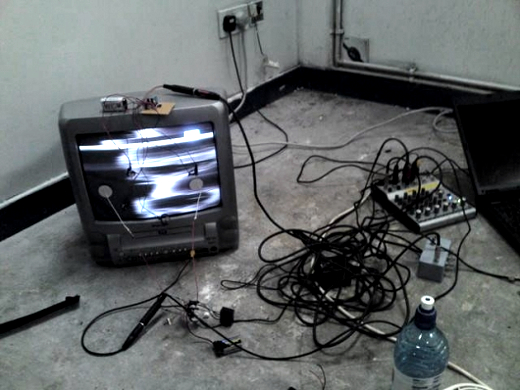
Ryan Jordan | Channelling Interferences
“Bio signal noise, music for flesh, psychosis attacks, the body is integrated”
http://nnnnn.org.uk/doku.php?id=noise_150811
Featuring performances by:
Atau Tanaka – “Concrete Corps is a musical concert performance for performer and bio-electrical interface as musical instrument. The instrument in question is the BioMuse, a sensor interface captures electromyogram (EMG) biosignals reflecting muscle tension. Biomedical electrodes make electrical contact with the skin, detecting electrical impulses of neurons as the brain commands voluntary muscle contraction.”
Marinos Koutsomichalis – “Sygxysis – a disturbance of psychological or mental health, psychological unrest, unrestful vexation) is a study in complexity using recursive stochastic noise generators. Sygxysis attacks the audience with intense spectra to enact situations of discomfort and psychological unrest, setting this way both body and consciousness into a constant state of alert and resulting in a profound awareness shift.
Ryan Jordan – “The audio static buzz and noise is momentarily hijacked as stray pirate radio frequencies are channelled and received through human flesh and bone.”
Marco Donnarumma – “Music for Flesh II is a seamless mediation between human biophysical potential and algorithmic composition. By enabling a computer to sense and interact with the muscular potential of human tissues, the work approaches the biological body as a means for computational artistry.”
Show info:
Monday August 15th
8-11pm
£5 suggested donation
rough bar
nnnnn Unit 73a, Regent Studios, 8 Andrew’s Road, E8 4QN
(get in the lift and go to the 7th floor, turn right and its the second unit)
I have been invited to the ICMC 2011 to give a lecture about the state of my current research in biophysical music. A related paper “Xth Sense: a study of muscle sounds for an experimental paradigm of musical performance” will be published in the ICMC proceedings.
“Since 1974 the International Computer Music Conference has been the major international forum for the presentation of the full range of outcomes from technical and musical research, both musical and theoretical, related to the use of computers in music… The theme of the 2011 conference is innovation : interaction : imagination emphasising the importance for our field of innovative technical developments, imaginative responses to new situations and, above all, the creative interaction of the technical and the musical.”
My participation to the ICMC in Huddersfield would have not been possible without a PRE travel grant awarded by The University of Edinburgh.
“A high-tech music weekender, BEAM is a playground of homemade instruments and sonic robots, focused on electronic music being performed or created LIVE.”
The Beam Festival was an inspiring event; packed with an incredible line-up including Stelarc, Atau Tanaka and Adam Parkinson, Alex Nowitz, Dj Sniff, Ryan Jordan and many others, it offered 3 days of absolute sonic pleasure. Me and colleague Christos Michalakos were awarded a bursary for “outstanding work”, respectively for Music for Flesh II and Frrriction, thus we had the pleasure to perform at the Artaud building during the evening concert sessions.
A complete report of the event is available at my personal blog.
In the end of May I’ve been invited to direct the second edition of Host Guest Ghost, an artistic residency in partnership with The Danish National School of Theatre and Contemporary Dance. The project was supported by The Danish Arts Council and Augustinus Fonden.
The project aimed to foster experimental approaches to dance, theatre and interactive technologies while forming emerging, talented choreographers and creatives. Together with a team of 6 dancers, 3 musicians and a professional chef, we developed a new intermedia piece titled “Raw/Roar”. The piece unveiled a peculiar, unique world of enhanced bodies, biophysical sound, augmented music and reactive videos. Among the different media and technologies explored during the residency, the main focus was set on the Xth Sense.
It was a challenging experience; initially, the dancers found some difficulties to combine their practice with the interactive framework provided by the Xth Sense, but after enough practice and open discussions about the motivation and aesthetic of the system, we defined a common terrain. However, it has been inspiring to realize how differently a musician and a traditionally trained dancer can approach the model of biophysical music. It is perhaps purely logical; whereas the former explores movement as a means towards a transparent externalization of a sound form, the latter is submerged in such a physical self-awareness that the idea of an incarnation through her body of a projected sound can be constraining.
I believe such idea is worth a further analysis on the nature and extendability of the Xth Sense; I would love to collaborate again with dancers to gain more insights about movement, music and performance.
As soon as the documentation will be ready I will post some pictures and videos.
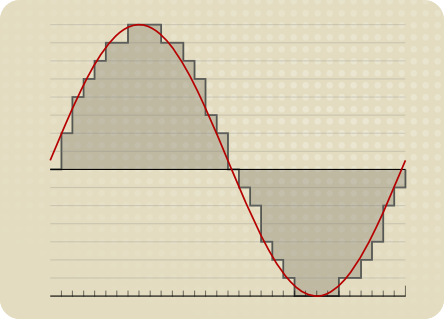
source: pcm.svg, available from http://commons.wikimedia.org/wiki/File:Pcm
The Linux Audio Conference (LAC2011) was held at NUI, National University of Ireland in Maynooth in the beginning of May.
My paper “Xth Sense: researching muscle sounds for an experimental paradigm of musical performance” and a related performance “Music for Flesh II” were both selected for the conference.
So far, the LAC has been one of the best conferences I took part in, both for the diverse and top-notch quality content offered, and for the easiness of social networking. A great place to be, indeed.
Thanks go to Victor Lazzarini, John Lato, Frank Neumann, Robin Gareus, Rory Walsh and all the NUI and LinuxAudio.org team. All presentations were streamed live and recorded. Definitely a great and valuable effort.
If you missed the event, make sure to check the program on-line, you will find an impressive source of ideas, knowledge and technical insights.
Here’s a complete video recording of my talk; an in-depth presentation of earlier methods and findings on the Xth Sense and muscle sounds.
The slides used in this presentation are also available for download at the LAC website.
All material is CC licensed, see the LAC website for detailed information.
Drawing from the stimulating conversations we all had in Maynooth I could extract some more ideas around muscle sounds. Above all some friends made me realized that I still didn’t analyzed in depth muscle sounds as for FFT and detailed frequency responses; although FFT has not proved effective, some statistical documentation about the sonic matter I’m working with could possibly disclose new insights.
Besides, a colleague working in the field of Biomedical Engineering reminded me that human body is composed of two different muscles, namely short and long muscle. Whereas long muscles are used for slow and light contractions, short muscles handle faster and stronger contractions. This observation might be useful while planning the location of four sensors on the performer’s body. I still couldn’t try this myself, but this is one of the next ideas I would like to actualize this year.




